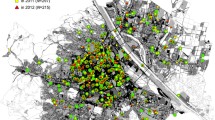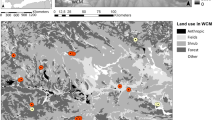Abstract
Approximately 200–250 pairs of kestrels (Falco tinnunculus) breed in Berlin, preferentially in nest boxes. From 2002 to 2004, ten monitoring sites (breeding sites) characterised by different housing structure, land utilisation, vegetation cover and degree of building density were studied in Berlin: four in the city centre, three in a mixed zone and three in the outskirts. All pairs bred in nest boxes, so the reproductive success could easily be determined. Pellets, and feathers of bird prey species, were collected during the breeding seasons, and the food spectrum was determined based on these remains. There was no significant difference in the reproductive success of the kestrels between the three zones. Data on the number of fledged young indicated a sufficient food supply. In total, 9 species of mice and shrews, 23 bird species and 31 beetle species were identified as prey of kestrels. Urban kestrels specialise in hunting birds if mice and shrews are not readily available, with the house sparrow (Passer domesticus) as the favoured prey bird. Of note are anthropogenic food items, such as cutlet bones, that were found only in the city centre. This shows that the kestrel can adapt itself to humans with regard to its diet. There was no urban gradient with regard to reproductive success, but there was with the composition of food, such as the domination of bird prey in the city centre. The number of individual items of bird prey decreased from the centre to the outskirts. In conclusion, the results show that the kestrel is an opportunistic species which survives well anywhere in the city of Berlin.



Similar content being viewed by others
Notes
Because of construction work at one site, there was no kestrel brood in 2004, so we had to choose an alternative, similar breeding site in the city centre in this breeding season
Kestrels in Berlin seldom fly a greater distance for hunting (own observations), but it seems obvious that kestrels have a “main hunting range” within a radius of 1 km around their breeding site. Definite data on this could only be gained with the help of telemetry, which was not possible with this project
Food supply of five nestlings in their first 35 days of life: approx. 310 house sparrows (1–7 days old: 1/day/nestling; 8–35 days old: 2/day/nestling). Food supply of the adults in 35 days: approximately 140 house sparrows (2/day/adult bird). Together this would be 450 house sparrows, but since, from the pellet analysis of 70% bird pellets and 18% mixed pellets with high proportions of birds (see Fig. 2) , one can estimate that kestrels in the city centre feed on c. 80% birds and c. 70% of those are house sparrows, the adjusted figure is 252.
References
Beichle U (1980) Siedlungsdichte, Jagdreviere und Jagdweise des Turmfalken (Falco tinnunculus) im Stadtgebiet von Kiel. Corax 8:3–12
Böhner J, Schulz W, Witt K (2003) Bestand und lebensraumspezifische Dichten des Haussperlings in Berlin. Artenschutzreport 14 (Sonderheft):13–17
Galanos I (1991) Beitrag zur Lebensweise des Turmfalken (Falco tinnunculus) in urbanen Ökosystemen und zur Kenntnis anthropogener Einflüsse auf die Population am Beispiel der Stadt Frankfurt am Main. Diss. Fachbereich Biologie, Frankfurt (Main) University
Glutz von Blotzheim UN, Bauer KM (1989) Handbuch der Vögel Mitteleuropas: Falconiformes, Bd. 4. Aula, Wiesbaden
Hasenclever H, Kostrzewa A, Kostrzewa R (1989) 16jährige Untersuchung zur Brutbiologie des Turmfalken (Falco tinnunculus) im Raum Bielefeld/Ostwestfalen. J Ornithol 130:229–237
Kostrzewa R, Kostrzewa A (1993) Der Turmfalke: Überlebensstrategien eines Greifvogels. Aula, Wiesbaden
Krampitz HE (1948/1949) Beitrag zur Lebensweise und Ernährung des Turmfalken in der Großstadt. Vogelkundl Beob Station “Untermain”, Jubil Ber, pp 20–30
Kurth D (1970) Der Turmfalke im Münchener Stadtgebiet. Anz Ornithol Ges Bayern 9:2–12
Kupko S, Schlottke L, Rinder J (2000) Der Turmfalke (Falco tinnunculus L.) im Berliner Stadtgebiet- Eine Auswertung unter besonderer Berücksichtigung der Monitoringsfläche Nr. 376 (Berlin-West). Populationsökologie Greifvogel und Eulenarten 4:359–372
Kupko S, Schlottke L, Rinder J (2005) Ergebnisse der Beringung von Turmfalken (Falco tinnunculus L.) in Berlin Eine Auswertung unter besonderer Berücksichtigung der Monitoringfläche Nr. 376 (Berliner Westbezirke). Populationsökologie von Greifvogel und Eulenarten 5 (in press)
Luniak M (2004) Synurbization adaption of animal wildlife to urban development. In: Shaw WW, Harris LK, Vandruff L (eds) Proceedings of the 4th international symposium on urban wildlife conservation,Tucson, Arizona, pp 50–55
Mammen U, Stubbe M (2001) Jahresbericht 2000 zum Monitoring Greifvögel und Eulen Europas. Jahresber Monitoring Greifvögel und Eulen Europas 13:1–99
Meyer W, Eilers G, Schnapper A (2003) Müll als Nahrungsquelle für Vögel und Säugetiere: Ein Beitrag zur Ökologie der Industriegesellschaft. Westarp Wiss., Hohenwarsleben
Otto W, Witt K (2002) Verbreitung und Bestand Berliner Brutvögel. Berl Ornithol Ber 12, Sonderheft
Piechocki R (1991) Der Turmfalke. Die Neue Brehm-Bücherei 116. Ziemsen, Wittenberg Lutherstadt
Rejt L (2001) Peregrine Falcon and Kestrel in urban environment—the case of Warsaw. In: Gottschalk E, Barkow A, Mühlenberg M, Settele J (eds) Naturschutz und Verhalten. UFZ-Bericht 2/2001:81–85, UFZ Leipzig-Halle, Leipzig
Salvati L, Manganaro A, Fattorini S, Piatella E (1999) Population features of kestrels Falco tinnunculus in urban, suburban and rural areas in central Italy. Acta Ornithol 34:53–58
Village A (1990) The kestrel. Poyser, London
Acknowledgements
We thank the following for help with the determination of prey species: Dr. Johannes Frisch (beetles), Dr. Kurt Günther (grasshoppers), Rainer Altenkamp and Stefan Schulz (birds), Tobias Teige (mice and shrews). Special thanks to PD Dr. Jörg Böhner for proofreading and constructive comments, and to Dr. Sarah Poynton for improving the language. Permission for monitoring breeding sites was generously given by the Senatsverwaltung für Stadtentwicklung und Umweltschutz Berlin. This study received financial support from the Deutsche Forschungsgemeinschaft (GRK 780). This research project complies with the current laws of Germany.
Author information
Authors and Affiliations
Corresponding author
Additional information
Communicated by F. Bairlein
Rights and permissions
About this article
Cite this article
Kübler, S., Kupko, S. & Zeller, U. The kestrel (Falco tinnunculus L.) in Berlin: investigation of breeding biology and feeding ecology. J Ornithol 146, 271–278 (2005). https://doi.org/10.1007/s10336-005-0089-2
Received:
Revised:
Accepted:
Published:
Issue Date:
DOI: https://doi.org/10.1007/s10336-005-0089-2




